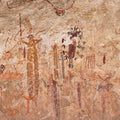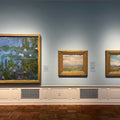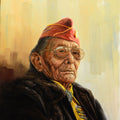Osage Artist Norman Akers Responds to Five Months in Philadelphia
By Chadd Scott on
Norman Akers (b. 1958; Wahzhazhi/Osage) completed the inaugural Edgar Heap of Birds Family Artist in Residence at the Tyler School of Art and Architecture at Temple University in Philadelphia at the end of May. Akers put aside his job as a professor of painting in the Department of Visual Art at the University of Kansas, and starting on January 2, 2025, focused exclusively on his own painting.
It was a rare opportunity. Most working artists work other jobs to help make ends meet. They’re teachers, gallery assistants, art handlers. They often balance this with kids and families, leaving available time to paint or sculpt or draw for the overnight hours, weekends, bits and pieces here and there.
January through May 2025 was a totally different experience for Akers.
“To be able to spend eight to 10 hours a day in the studio and then go home and live and breathe it – my routine was, a minimum of five days a week, most of the time six days, I'd be in the studio, eight to 10 hours,” Akers said. “I would photograph my work. I would take it home with me. I would look at it on the computer and think about what I was going to do the next day. I basically went in and worked, and to live in that space for that amount of time was just incredible.”
Not only the number of hours, but the number of uninterrupted hours. Uninterrupted days. Uninterrupted weeks. The singular focus.
Instead of trying to work around grading and building lesson plans and giving lectures, Akers could stay in the creative zone, totally centered on his own work, thinking more and more deeply about what he was doing, where he wanted to take it.
“Print making, I can pick up, I can turn off, I can pick up, and turn off, and work that way. I can work in stages, but painting’s a different story,” Akers explained. “Painting really involves being completely engaged with the work to get to a certain level of resolve. That's what this time gave me. Having that time to stay focused and live in this creative moment was important in terms of its impact on my work.”
At 66-years-old, Akers is well-established. His work resides in prominent museum collections. His elk are a notable signature in contemporary American art. That combined with his professor position at one of America’s great universities make it easy to coast. To create more of a similar kind of work he knows there’s an interest and market for.
“I don't want to sit back and rely just on what I've done and repeat what I've done in the past,” Akers said. “That experience of working in Philadelphia, from that place, and looking back at home, has kind of got me to rethinking what painting is. I'm seeing a new conversation on the horizon with the work.”
As much as all the time in Philly to work was beneficial, the place, too, opened up new ideas for him.
“Philadelphia is the birthplace of American colonialism, so to work from that location, and then think about the notion of Indigenous land was important,” Akers said. “The work that came from the residency really spoke to this moment in time about environmental issues and colonialism. The iconography that I'm working with is growing and evolving, as I am as an artist, and that's essentially what I was looking at doing, and I feel like I achieved it.”

Norman Akers, 'New World Obstacles,' 70” x 60”, oil on canvas, 2025. Photo by Norman Akers.
Philadelphia
Akers grew up in Fairfax, OK in the Osage Nation. He’s never spent much time on the East Coast or in big cities.
What did he think of Philadelphia?
“I have to admit, I loved it! Being in the city, everything felt new, and there's a heightened awareness of your environment,” Akers said. “There was something about Philly, staying in an extended period of hyper-awareness of place I thought was incredible. I tend to be a walker. I'm a person who would take the bus or the subway, get off and have no agenda and just start walking. Walk for half a day or a full day sometimes. In the city, it doesn't take long to transition from one sort of space to another, and they could be radically different, almost like walking through different worlds.”
Of course, being on the East Coast provides opportunities to visit the great East Coast art museums. Akers highlighted the Chaim Soutine paintings at the Barnes Collection in Philadelphia, the Zimmerli Art Museum at Rutger’s University in Brunswick, NJ’s “Indigenous Identities” exhibition, of which his work is included, plus gallery shows for fellow Native American artists Brad Kahlhamer, and Yatika Starr Fields in New York as his favorites.
Ever the professor, Akers did spend some time with the Temple students.
“We just talked painting,” Akers said. “There's times where (painters are) very concept driven, and clearly my work deals with many issues that are layered in, but also just on a real basic level, with a lot of the undergrads, it's talking about the act of painting, the process of what you go through and what you're thinking about making a painting.”
This fall, Temple Contemporary, Tyler’s center for exhibitions and public programming, will host a solo show for Akers featuring the paintings he created while in residence.
The working title is “Navigating New Places.” Appropriate. Philly will be all over it.
“(There’s a) Liberty Bell painting. My take on it was quite different than the patriotic and it came as a response from going to Old City, looking at all these historic sites, wandering through these places and realizing that this is one part of America, but it's a challenging history as a native person to deal with,” Akers said.

Norman Akers, 'Seeing Through the Myth,' 50” x 46.5”, oil on canvas, 2025. Photo by Norman Akers.
Edgar Heap of Birds
The Edgar Heap of Birds Family Artist in Residence, obviously, relates to multimedia artist, educator, and activist Hock E Aye VI Edgar Heap of Birds (b. 1954, Wichita, Kansas; Cheyenne and Arapaho Nation), a Tyler alum (MFA 1979). Heap of Birds is one of the most prominent contemporary artists in America – Native or otherwise – with work in the nation’s most prestigious museums. His paintings are best known for their dramatic use of text.
Heap of Birds came up with the idea and financial support to bring artists to Temple whose work focuses on the history and lived experience of North American federally recognized tribal citizens. Artists who exemplify the art and activism of the residency’s namesake. Artists bringing attention to the lives, struggles, and triumphs of Native Americans.
Artists just like Akers.
Coincidentally, Heap of Birds received his undergraduate degree from KU, where Akers teaches. Heap of Birds has donated money to that art program as well, and also has a gallery space there named after him. Both artists are from Oklahoma.
Akers first remembers encountering Heap of Birds’ artwork through an exhibition Heap of Birds organized that visited the Institute of American Indian Arts in Santa Fe’s museum in the early 1980s.
“I remember coming out of undergrad and being in the museum program, and I when I saw that work, I just went, ‘Wow, this is completely new.’ I was quite taken by it,” Akers said.
The two became professional acquaintances, have traded paintings, and have stayed in touch ever since. Despite that, the residency wasn’t an inside job. Akers applied for the position along with dozens of others and was selected through a rigorous process.
Now Akers is focused on keeping the momentum this residency opportunity has created.
“I shared this with the (Tyler) people before I left, I said, ‘You really don't know how important – or maybe you do – but this is a very important thing for me personally,’” Akers said. “I couldn't explain to them exactly how much they had helped. Right now, I’m feeling good about the work.”



